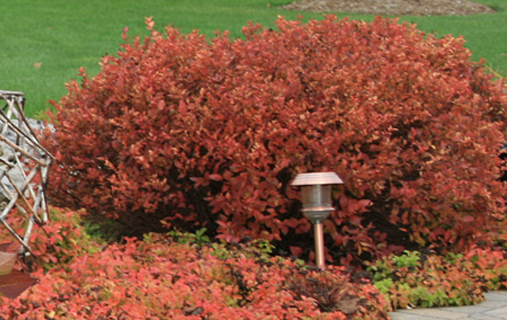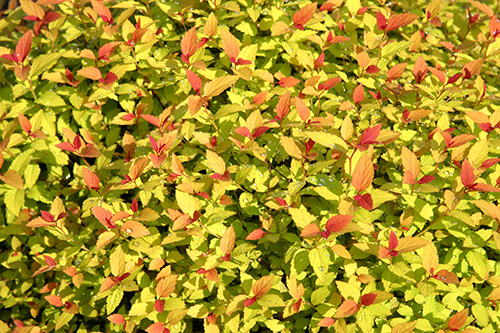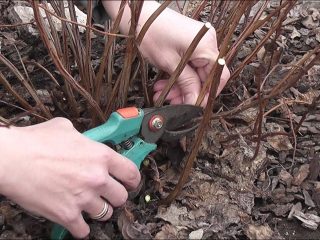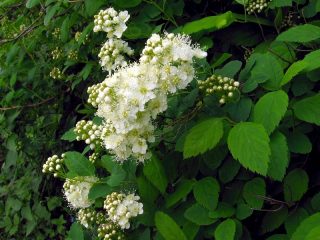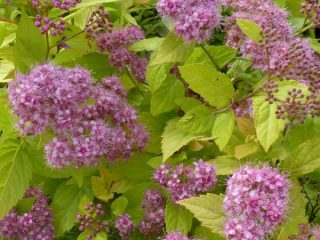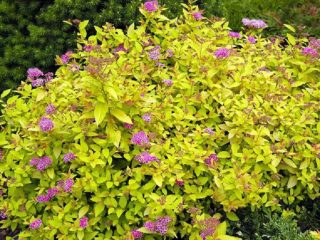Content
A wide variety of shrubs are used as ornamental plants. More and more fans of landscape design are choosing spirea for decoration. There are several variations of this plant. Japanese Spiraea Firelight is suitable for decoration in a variety of forms. Looks great near water and as a hedge.
Description of Spirea Firelight
The lush flowering of such a shrub will always attract the attention of beauty lovers. Externally, it is a small shrub that does not grow higher than 60 cm. The branches are arched and hang down to the ground, which gives the spirea a unique appearance. The shrub is especially attractive due to its changing foliage colors during the fall. When young, the leaves have a bright red, fiery color. During the summer the foliage turns greenish-yellow and then turns bright red again.
The shrub blooms with pink inflorescences from June to September. The inflorescences have a corymbose shape and are located on the shoots along the entire length. It is a summer flowering shrub with a slow growth rate.
Japanese Spiraea Firelight in the description is presented as a small spreading shrub with a crown diameter of up to 80 cm.
Japanese Spiraea Firelight in landscape design
Professionals in the field of landscaping use Japanese spirea in a wide variety of methods. This is a very spectacular shrub that looks great as a decoration for any area. The plant is used:
- for decorating paths;
- in hedges;
- in rock gardens;
- near artificial lawns;
- group and single plantings;
- groups on the lawns.
Japanese spirea looks very beautiful next to large plants. This small hedge looks best when used as a border around garden paths.
Planting and caring for Firelight spirea
In order for the plant to bloom twice a year and decorate the site with its healthy appearance, it is necessary to strictly follow agricultural practices and properly care for the bush. No special care is required; it is enough to regularly water, feed, carry out formative and sanitary pruning and prepare the shrub for winter. It also helps to prevent diseases and pests.
Preparation of planting site and seedlings
Japanese firelight spiraea (spiraea japonica firelight) requires a sunny place, perhaps with light partial shade. The soil must be thoroughly dug up before planting, since the plant loves breathable and fertile soil.
Shrubs can be planted in both autumn and spring. Autumn planting is considered preferable. In spring it is necessary to catch the sap flow, while in autumn the optimal time is the period of leaf fall.
To plant, you will need to dig a hole with a diameter of 50 cm. In any case, the diameter of the hole should be larger than the root system.To the excavated soil you should add 2 parts of leaf soil, part of turf, half of humus, the same amount of sand, part of non-acidic peat.
Be sure to install drainage in the hole.
Before planting, be sure to check the root system and remove diseased, dried out and too limp roots.
Planting Japanese spirea Firelight
After the hole and planting material have been prepared, you can begin planting. It is best to do this on a cloudy day.
The seedling should be placed in the center of the prepared hole, the root collar should be 3–5 cm on the surface. The root system should be lightly sprinkled with earth, then tamped down and soil should be added again, all the way to the surface.
Be sure to pour 1.5–2 buckets of warm water under the bush. This way the bush will receive a sufficient amount of moisture to the nutritious soil.
The best option is to mulch with peat at the end of planting.
Quick rooting and the ability to adapt well will help make the area a blooming garden next year. The plant will delight the owner with its flowering shoots for several months in a row.
Watering and fertilizing
The Spiraea bush is undemanding when it comes to feeding. If, during planting, you pour a combined fertilizer or a special fertilizer for shrubs into the hole, then in the first 2 years you no longer need to think about fertilizing or adding additional substances. The shrub will be sufficiently supplied with initial nutritional supplements.
Then fertilization will be required, preferably in early spring. Mineral and organic fertilizers are applied in a comprehensive manner so that the plant has all the necessary microelements for full development.
As a fertilizer, apply a mixture of water - 6 liters and mullein - 10 liters.10 g of superphosphate is also added there. This mixture is enough to feed the bush for the whole year. If the soil is fertile enough, then it is quite possible to do without fertilizer.
Spiraea is considered a drought-resistant plant, and excessive waterlogging can be harmful. A sufficient dose for an adult shrub is 20 liters of water for 7 days. A slightly higher dosage for young spirea during the rooting period.
Trimming
After planting, you don’t have to do any pruning for the first two years. Then comes formative pruning, which is carried out after the shrub has flowered. In single plantings, the plant is most often given the shape of a ball, and in group plantings - a rectangle.
Old branches should be pruned every 3 years. To do this, they are cut right at the base. It is imperative to inspect the plant annually for the presence of diseased and damaged shoots, which are also removed as part of sanitary pruning.
Preparing for winter
Japanese spirea tolerates winter well. It can withstand frosts down to -40 °C. But you should cover the root part if the winter is expected to be severe or too frosty. It is also recommended to cover the shrub if it is planted in the northern regions of the country with a harsh climate, where winter lasts a long time and is characterized by severe frosts.
As a shelter, you can use hay or straw to mulch the root zone. In the spring it is worth inspecting the plant and removing frozen shoots.
Reproduction of Japanese spirea Firelight
Spiraea japonica Firelightna photo looks very beautiful, it will serve as a decoration for the site for a long time, but it must be propagated correctly. This shrub is propagated in several ways to choose from:
- cuttings;
- layering;
- seed method.
With the help of cuttings, it is excellent to preserve all the characteristics of a particular variety, and therefore it is better to use this particular method. Partially lignified shoots no older than a year are used as cuttings. Cuttings 15 cm long are enough. The lower part needs to be dipped in a special solution to form roots and planted in fertile soil.
To form layering, young shoots need to be pressed into the dug groove and pinned with metal staples. Then sprinkle with soil so that the top of the shoot is on the surface. Thus, if you constantly water the shoot, then by autumn you can safely replant the plant to a permanent place of residence.
Diseases and pests
Japanese spirea has strong immunity and resists many infections and fungal diseases. But there are several types of pests that can cause serious damage to an ornamental plant:
- Aphid is a common pest that can be saved from using a standard tobacco or soap solution.
- Spider mite — holes in the inflorescences of the pest are revealed, as well as dry and fallen out-of-season leaves. To combat the pest, there are several types of different drugs that should be used strictly according to the instructions.
- leaf roller - usually appears at the end of May. It got its name for the characteristic symptoms that appear on the leaves of the bush.
If you follow all the rules of agricultural technology, the plant will be able to resist pests. It is also important to inspect the bush and detect the first symptoms of the appearance of uninvited guests in time.
Reviews of Spirea Firelight
Conclusion
Japanese Spiraea Firelight is popular among both landscape design professionals and amateurs. Its main advantage is its ease of care and luxurious appearance during flowering. Splendor can be used in both single and group plantings in combination with large trees.

